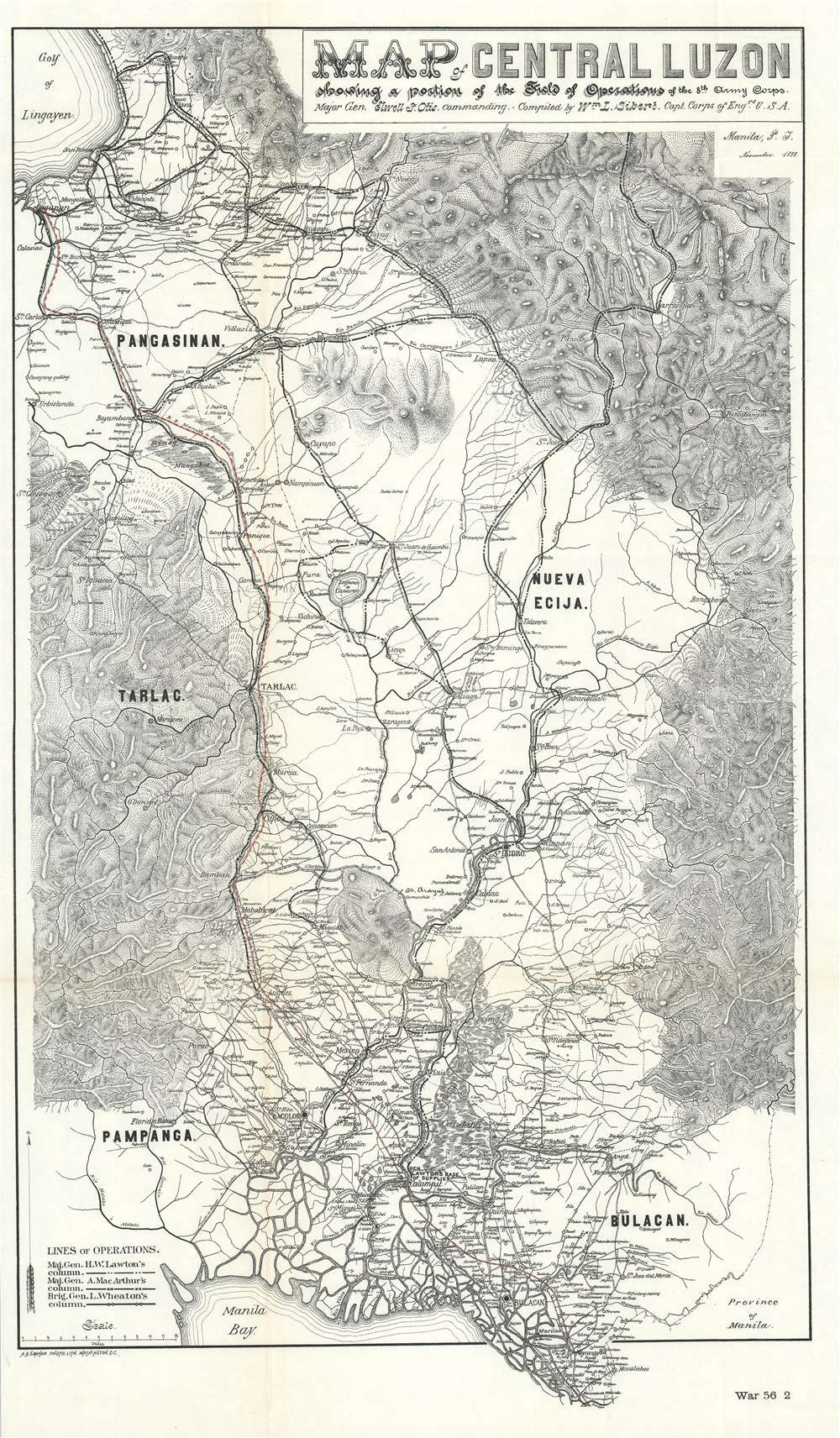1899 Otis Map of Central Luzon, Philippines, during the Philippine-American War
CentralLuzon-otis-1899-2
Title
1899 (dated) 27 x 15.5 in (68.58 x 39.37 cm) 1 : 260000
Description
A Closer Look
Coverage embraces central Luzon, including Manila, and the area just north of Manila and Manila Bay to Lingayen Gulf. During the early stages of the Philippine-American War, this was the most active theater and largely controlled by Philippine forces. Three different 'lines of operations' are illustrated, marking the advance of troops under Major General Henry Ware Lawton, Major General Arthur MacArthur Jr., and Brigadier General Loyd Wheaton, respectively. Roads and telegraph lines are illustrated, and topography is expressed through hachure.The Philippine-American War
The Philippine-American War lasted from February 4, 1899, until July 2, 1902, when the Philippine Organic Act established the Second Philippine Commission and Philippine legislature. The war immediately followed the Spanish-American War, set off once the Filipinos realized that the Americans were in the islands to stay. Estimates of Filipino civilian casualties vary wildly, from 200,000 to over 1,000,000, the majority of which were caused by famine and disease. Armed resistance to the U.S. occupation of the Philippines continued as a guerrilla insurrection in many parts of the archipelago until June 1913. The U.S. passed the Tydings-McDuffie Act, also known as the Philippine Independence Act, in 1934. This law created the Commonwealth of the Philippines, increased self-governance, and scheduled Philippine independence for 1944. World War II delayed this process, and the U.S. did not grant full autonomy to the Philippines until 1946.Publication History and Census
This map was prepared by William L. Sibert, a captain with the 8th Army Engineering Corps, on the order of Major General E. S. Otis, and was printed by A. B. Graham Photo Lithography of Washington, D. C. It appears to be quite scarce, with only one example identified in the OCLC. We know of only one other example in a private collection.CartographerS
Andrew B. Graham (1845 - September 9, 1909) was an American lithographer active in Washington, D.C. in late 19th and early 20th century. Graham was born in Washington D.C., the son of a lithographer and engraver. After college, he joined the U.S. Coast Survey, where he was a draftsman until 1889. He retired from the Coast Survey to take over management of his father's lithography firm. The firm, Andrew B. Graham Company, was one of several that thrived on lucrative government publication contracts. Graham died of 'brain fever' in his Washington D. C. residence on September 9 of 1909. Some of his work was republished posthumously until about 1917, and his firm was active until at least the early 1920s. More by this mapmaker...
Elwell Stephen Otis (March 25, 1838 - October 21, 1909) was a United States army officer who served in the American Civil War, Indian Wars, the Philippines late in the Spanish-American War and during the Philippine-American War, where he commanded the Eighth Corps. He served following the Philippine-American War as the Military Governor General of the Philippines. While not popular in the Philippines due to his authoritarian and 'pompous' manner, he was a skilled and capable administrator. Otis was replaced in the Philippines by the more popular Douglas MacArthur in 1900. Otis died in Rochester, New York on October 21, 1909 from painful angina. Learn More...
William Luther Sibert (October 12, 1860 – October 16, 1935) was a American army officer active in several foreign wars. Sibert was born in Gadsden, Alabama, and attended the University of Alabama before entering the United States Military Academy at West Point. Upon graduating he was commissioned into the Army Engineering Corps. During the Philippine-American War (1899-1902) he was appointed Chief Engineer of the 8th Army Engineering Corps, during which he oversaw the compilation of several important maps. During World War I, he was deployed with the first four regiments of the American Expeditionary Force in France. In June of 1918, Sibert was assigned to the War Department's newly created Chemical Warfare Service, which he led until 1920. Following the war Sibert retired from active duty and moved to Bowling Green, Kentucky. As a civilian he engaged in numerous improvement projects in Alabama and on the Hoover Dam. General Sibert is buried at Arlington National Cemetery. He was elected to the University of Alabama Engineering Hall of Fame oi 1961. Learn More...

